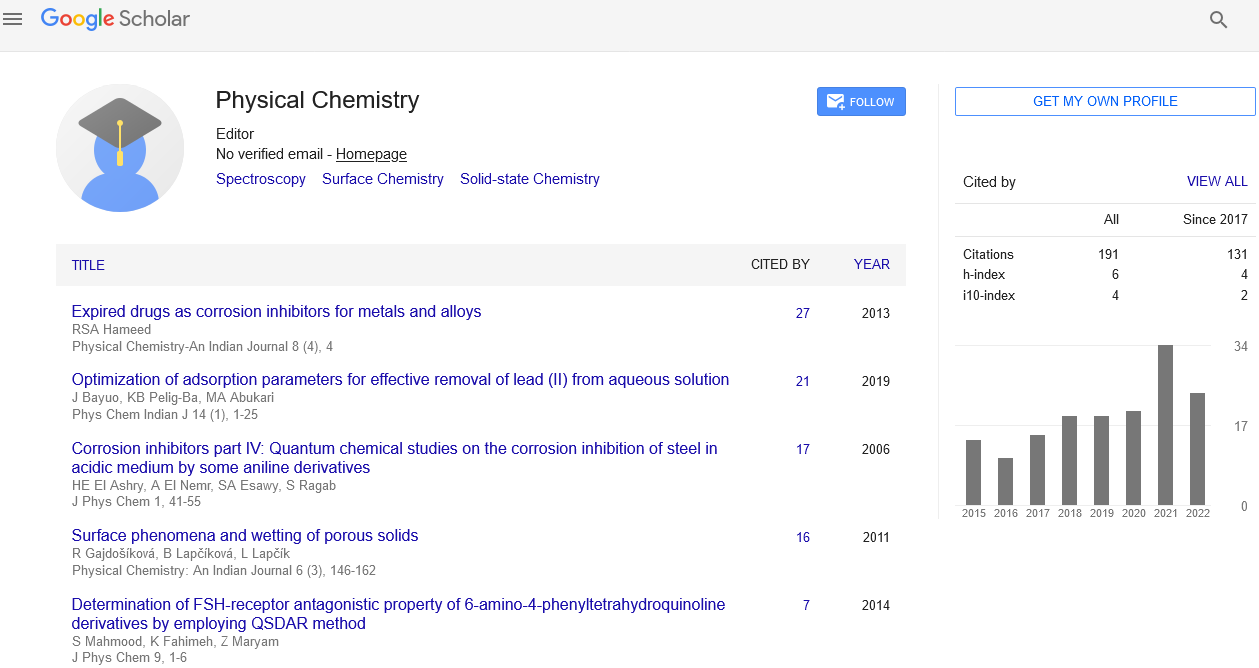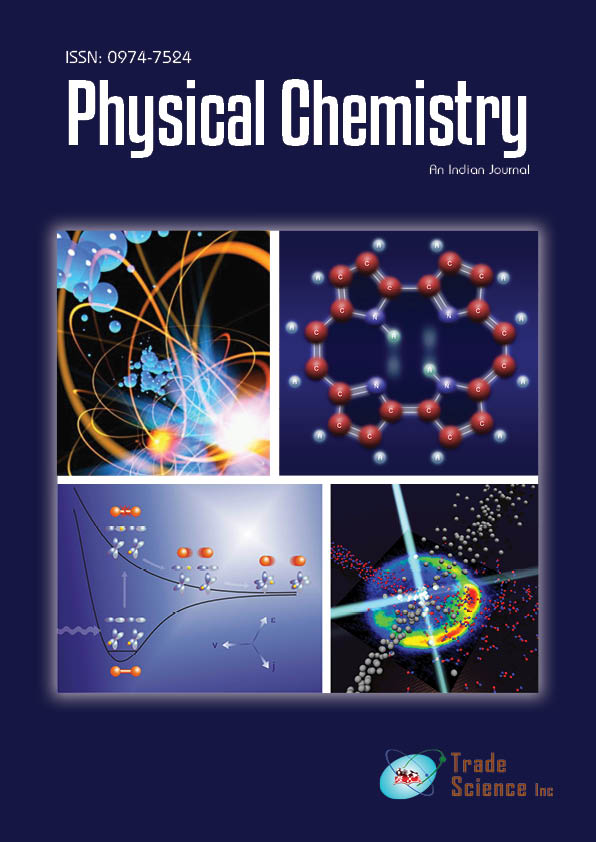Review
, Volume: 17( 1)Fundamentals of Biosensor Process Validation for Trace Element Quantitative Determination
Noah Jones *
- *Correspondence:
- Noah Jones
Editorial Office,
Physcal Chemstry: An Indian Journal,
United Kingdom,
E-mail: physicalchem@journalres.com
Received: January 03, 2022; Accepted: January 17, 2022; Published: January 24, 2022
Citation: Jones N. Fundamentals of biosensor process validation for trace element quantitative determination. Int J Chem Sci 2022;17(1):162
Abstract
Bioanalytical methods are used to quantitatively assess the quantity of medications, biotransformation products, or other specified chemicals in biological matrices, and are frequently used to assist regulatory submissions by providing important data to pharmacokinetic or bioequivalence studies. Bioanalytical methods are subjected to a thorough method validation process to guarantee that they can generate reliable, reproducible data that meets or exceeds current regulatory guidance. Regulatory advice does not always account for subtleties unique to trace element findings at the moment. From the authors' standpoint, this study is designed to provide guidance on trace element bioanalytical method validation for two common and powerful experimental techniques: inductively coupled plasma-optical emission spectrometry and inductively coupled plasma-MS.
Introduction
Drugs, biotransformation products, and other specified substances are quantified in biological matrices such as blood, tissue, serum, urine, and plasma using bioanalytical procedures. In support of regulatory submissions, these methodologies frequently give crucial data to nutritional, safety, pharmacokinetic/pharmacodynamics, or bioequivalence investigations. As a result, it's critical to make sure a bioanalytical approach can produce accurate, repeatable results. To that aim, the bioanalytical method validation procedure is meant to establish clearly that a bioanalytical technique is suitable for its intended use, including the critical concepts of reproducibility and transportability [1]. In the context of this study, method validation refers to the demonstration and confirmation of an established bioanalytical technique's suitability for the intended purpose after it has completed method development. To provide reliable, reproducible results that meet or exceed the performance requirements indicated in the appropriate Regulatory Guidance for the essential parameters of accuracy, precision, reproducibility, selectivity, sensitivity, and stability, robust method validation is necessary [2].
The rising importance of macromolecular medicines, as well as the frequency of small organic molecule medicines, has gained the attention of industry committees and regulatory bodies to bioanalytical method validation for these species. A chromatographic approach is often connected to a mass spectrometric detector (e.g., LC–MS/MS) for small-molecule measurements, while non-chromatographic ligand-binding assays are used for macromolecular studies (LBAs). As a result, properties relating to the size, structure, and detection modality of tiny and macromolecular molecules are included in best practices for bioanalytical technique validation of these species [3]. On the other hand, there is currently minimal information available on bioanalytical method validation for trace element determination. Furthermore, the bioanalytical support industry's limited information isn't usually standardized.
Many biological systems and therapeutic substances contain trace elements, and small changes in concentration inside an organism can have a big impact on nutrition, disease genesis, prevention, and therapy. As a result, their precise, repeatable detection in biological matrices is frequently crucial to the success of pharmacological, bioavailability, toxicological, and epidemiological studies. Although the validation process for trace elements is similar to that for small-molecule organic substances, there are some key differences in trace element test result validations due to their physicochemical characteristics. Because trace elements are so common in nature, it's critical to pay close attention to the analyses contribution from the reagents and the analytical procedure. Trace elements are generally intrinsic to biological matrices, and normal levels within a matrix can vary dramatically between samples as a result of food, other environmental exposure, and lifestyle choices [4]. As a result, even for non-endogenous components, establishing proper homogenization and digestion of a suitable control matrix is crucial.
Discussion
It is prudent for the analytical laboratory to thoroughly test the proposed bioanalytical method via a rigorous method development process before initiating formal validation. Method development activities for trace element determinations typically include judicious selection and evaluation of instrumental parameters associated with analyze and the IS, as well as assessments of analyze selectivity, linearity, sensitivity (analyses quantitation limits), recovery in the presence of a control matrix and likely interfering species, potential carryover, and sample homogeneity/representativeness [5]. The suggested sample preparation and analysis processes should, in theory, allow for consistent analyze identification at biologically relevant levels while taking into account any potential obstacles that may arise during bioanalytical sample analysis (e.g., endogenous analyze concentrations or occasional lip emic samples). If the validated method is to be transferred, selection should be taken into account during the development of transportable sample preparation and analysis parameters.
Depending on the application, speciation tests may be required in the analytical laboratory to ensure that analyze can be recovered from the control matrix when it is present in a specific chemical form or oxidation state [6]. Speciation’s experiments are usually carried out with a hyphenated approach, such as ion chromatography (IC)–ICP-MS, or with isotopically enriched, species-specific forms of analyze. Even if the final goal of the bioanalytical sample analysis is to determine the overall concentration of a trace element, these tests can often yield useful information and aid procedure development. The level of systematic and random errors (mean bias and variance, respectively) associated with repeated determinations of spiked control samples may be recognized as a crucial indicator of procedure effectiveness, as they identify the extent of method accuracy and precision (standards and quality control samples). In a comprehensive validation, at least five replicates of quality control (QC) samples at each level are assessed for relative robustness over at least two days by two different analysts in three different accuracy and precision runs. In practice, more facilities are evaluating six replicates at each QC level, but whether five or six, it's critical to employ the same number when certifying new QC levels or preparations, including dilute QCs [7]. Furthermore, the LLOQ's qualifying to validate the calibration range and limits, ULOQ samples are included in accuracy and precision testing. During the three accuracy and precision runs, the LLOQ-QCs are assessed three times in practice.
Prior to sample extraction or analysis, an IS for trace element analysis usually refers to an additional element that is introduced in a constant amount to the samples, calibration standards, and QC blanks and samples. By displaying the ratio of the analyze signal to the IS signal as a function of the analyze concentration, the IS response is incorporated into the calibration process. The IS should have ionization or atomization behavior that closely resembles that of analyze, allowing for continuous signal correction and monitoring of extraction or digestion efficiency of each sample, standard, and QC during normal instrument operation. When utilizing an IS to correct for a change in analyze signal during the typical ICP-OES measurement process, it's necessary to think about whether the IS element is solubility compatible with the (acid) matrix and whether there are any spectral interferences at the IS emission wavelength. The IS must also be contaminant-free, not present at measurable, endogenous levels in the sample matrix, and added at a concentration adequate to produce an acceptable signal-to-noise ratio. The IS element should have the same ICP intensity change pattern as analyze (same emission or ionization profile) [8].
As an analytical quality control measure, continuing calibration verification (CCV) controls are frequently used in element analysis laboratories. When ICP-OES or ICP-MS instrument software constraints prevent the use of bracketing calibration curves, these controls are frequently employed to investigate potential variations in analyze and IS instrument response owing to some kinds of ICP instrumentation. CCV controls are typically mid-level calibration standards, frequently without a matrix, that are examined at regular intervals to ensure that the calibration slope is not influenced by potential instrument response fluctuations throughout an investigation [9]. If CCV check is employed, pass/fail criteria based on instrument response (or determined concentration) is established in advance. Furthermore, these requirements are validated and become part of the validation method's acceptance criteria. CCV is used to regulate bracket samples in practice CCV controls bracket samples, and if a CCV control fails, bracketed samples are rejected. Optional CCV controls are only prepared at one level, and they do not replace the usage of mandatory matrix QC samples at the low, mid, and high levels.
Physical properties, the matrix, the biomarker itself, and the sample container system all affect biomarker stability in a biological matrix. Although the total concentration of a trace element in a biological matrix is usually stable, distinct chemical forms or species of an element might have drastically varied stability profiles [10]. For instance, different forms of the same element in a biological matrix, or in a matrix extract after sample preparation, can have drastically varying volatility, precipitation, and container-wall adsorption properties. As a result, while evaluating stability, it is advised that the likely form (or forms) of a trace element be considered. During method validation, several types of stability are evaluated. Stability tests should, to the degree practicable, replicate storage conditions that are anticipated to occur during sample collection, storage, and sample preparation sample analysis. The trace element stability tests that are required are detailed below [11].
Standard reference materials from a certifying agency, such as NIST, or stock solutions directly traceable to the reference material are common in elemental analysis. Although the certifying agency or the commercial stock solution provider may perform appropriate characterization of these solutions, it is still important to validate the quantification of the reference standard stock solution using a documented approach (usually described within an SOP). The option to use these standards directly as obtained prior to expiration can reduce the necessity to demonstrate stock solution stability [12]. During method validation, it's critical to document the circumstances in which the reference and IS, as well as associated stock reagents, are kept stable in order to meet the assay's basic requirements. To imitate the storage conditions of incurred samples, including shipment storage conditions, long-term storage stability testing should be performed. QC samples are created for at least two nominal concentrations (preferably, low- and high-QC levels) and tested in triplicate against a freshly prepared standard curve to assess long-term stability. Storage at -20°C is often sufficient for total trace element measurements, although -70°C storage may be more appropriate for the determination of organometallics or trace element species [13]. It's worth noting that the FDA recommends that samples maintained at -70°C be tested for stability at -20°C as well.
At least three QC sample replicates should be generated at a minimum of two levels (preferably, the low- and high-QC concentrations) and subjected to at least three freeze–thaw cycles to test freeze–thaw stability. Freeze–thaw QC samples are frozen for at least 24 hours at the proper nominal storage temperature before being thawed. Samples must be allowed to thaw completely at room temperature without assistance before being refrozen for at least 12 hours per cycle. For short-term and benchtop stability testing, QC samples are generated in triplicate for a minimum of two nominal concentrations (e.g., lowand high-QC levels). These quality control samples are kept at room temperature for a long enough time to cover all sample handling activities [14].
Conclusion
Many biological systems and therapies require trace elements, but there is currently minimal evidence on the validation of methods for determining them in biological matrices. Since a result, method validation techniques in the bioanalytical support business are not generally standardized, as laboratories seek to account for difficulties particular to trace element measurements in various ways. Although the method validation approach for trace elements and small-molecule organic compounds is essentially the same, there are some key differences in bioanalytical method validation for trace elements that stem from their physiochemical properties and most common detection modalities, such as ICP-OES and ICP-MS. Because many trace elements are quite common, particular attention to regulating analyze is required the chemicals' and analytical procedure's contribution is frequently advocated. Endogenous trace elements are common in biological matrices, and normal levels within a matrix might differ dramatically between samples. As a result, it's crucial to pay attention to establishing and homogenizing a proper control matrix.

